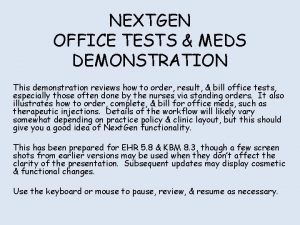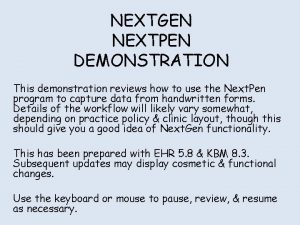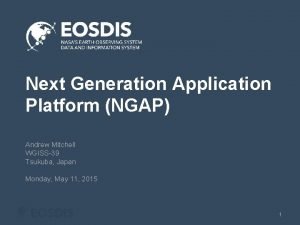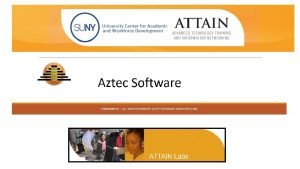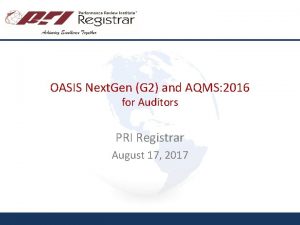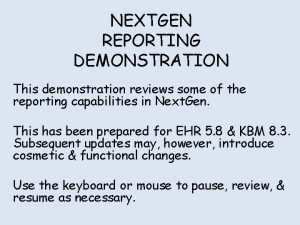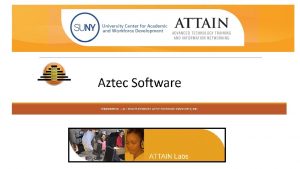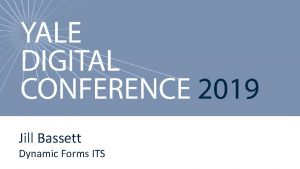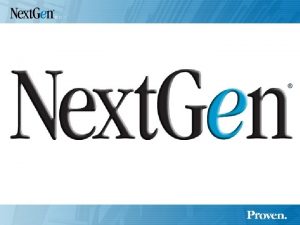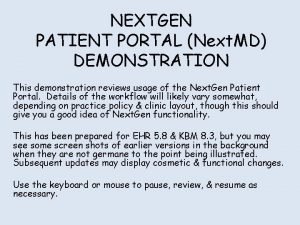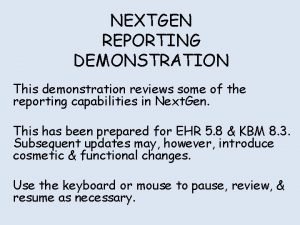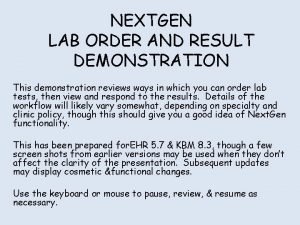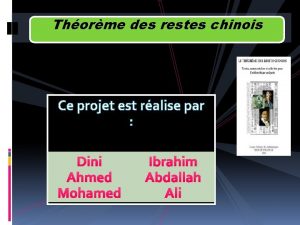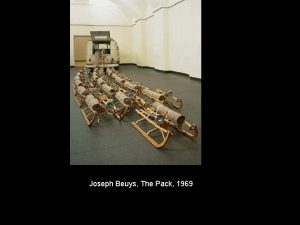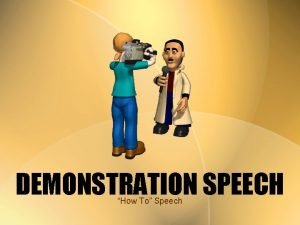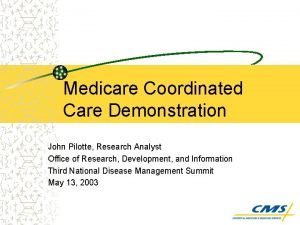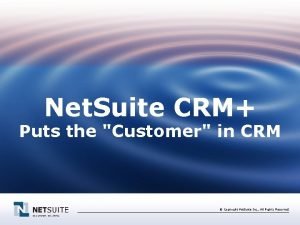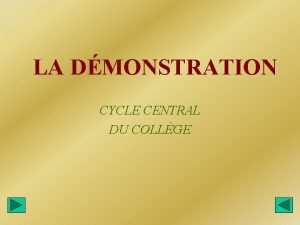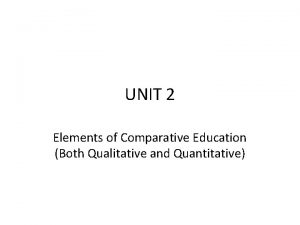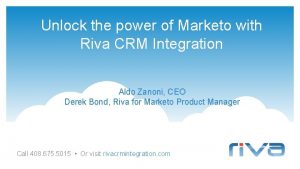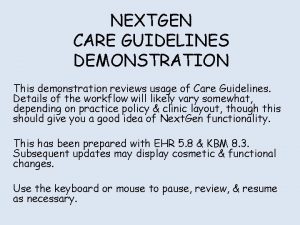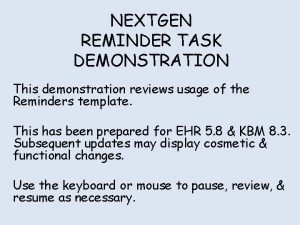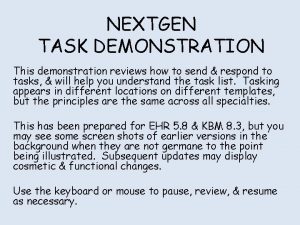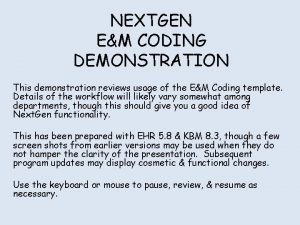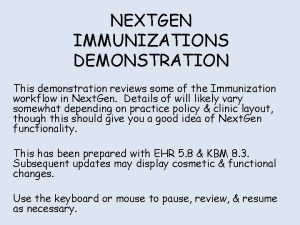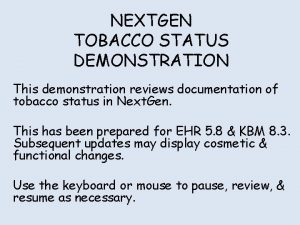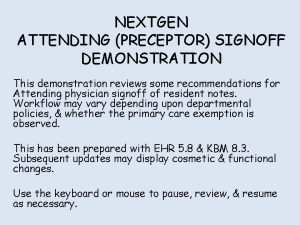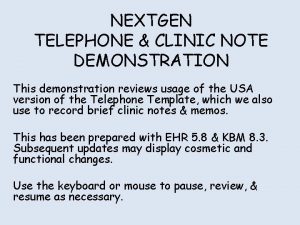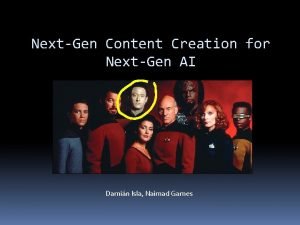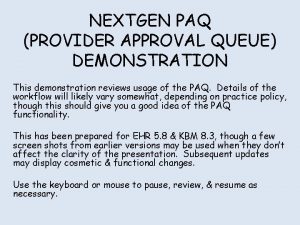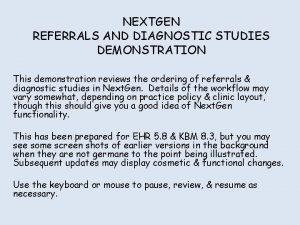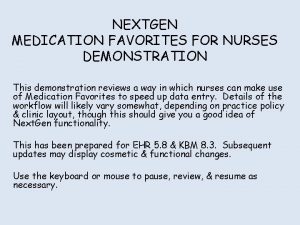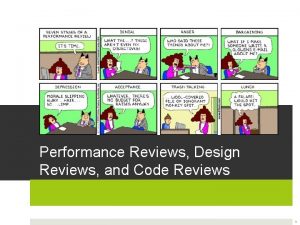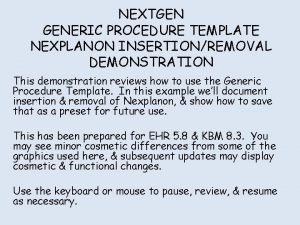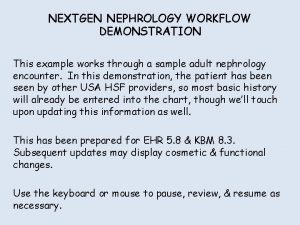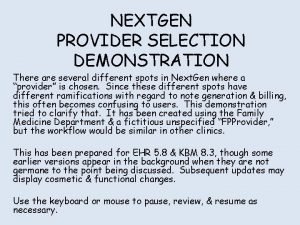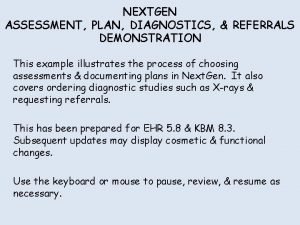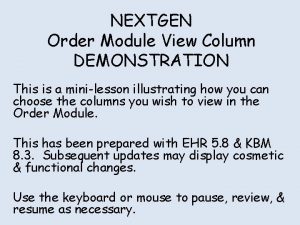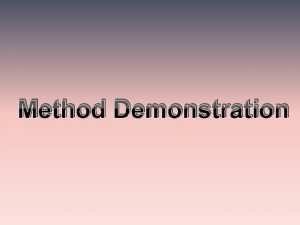NEXTGEN NEXTPEN DEMONSTRATION This demonstration reviews how to





























- Slides: 29

NEXTGEN NEXTPEN DEMONSTRATION This demonstration reviews how to use the Next. Pen program to capture data from handwritten forms. Details of the workflow will likely vary somewhat, depending on practice policy & clinic layout, though this should give you a good idea of Next. Gen functionality. This has been prepared with EHR 5. 8 & KBM 8. 3. Subsequent updates may display cosmetic & functional changes. Use the keyboard or mouse to pause, review, & resume as necessary.

Introduction Next. Pen is an optional Next. Gen system that combines a special pen & some additional programs to allow patients or users to capture data on handwritten forms, & to transfer at least some of that to the appropriate place within a Next. Gen chart. A common use for this would be to collect medical history information from new patients, so we’ll use that as the example in this demonstration.

Users in clinics that have Next. Pen will see a couple additional program icons on the desktop: Next. Pen Print & Next. Pen Desktop. First, we need to print a form; this will usually be done by someone in the front office. The best time to do this is at the end of the day, looking at tomorrow’s appointments. In whatever fashion is easiest, print a list of tomorrow’s new patient appointments. Make note of who are children & who are adults, since we have both pediatric & adult history forms. For Next. Pen purposes, you should use the adult medical history form for anyone beyond the 13 th birthday.

Then double-click Next. Pen Print. (If you’re not already logged on to Next. Gen EHR or PM, you’ll see a sign-on screen. )

Next. Pen Print opens. You’ll probably find it helpful to maximize this window. At the bottom you’ll see a list of available forms. While we’ll probably add more over time, the only ones we’re using at the time of this writing are Adult Medical History Form - USA & Pediatric Medical History Form - USA.

Now we need to see a list of scheduled appointments to find who needs to have a form printed. Click Query.

Begin by selecting Location (though for providers who only work in one location this is not really necessary). Then select Providers. Go ahead & check all providers in your clinic. This way from day-to-day you won’t have to do this again unless a new provider is added.

Then select the Date. As mentioned above, most of the time you’ll want to print a batch of these for tomorrow’s new patients, but you can also print one at a time if a same-day appointment is made with a new patient. When done, click OK.

You’ll see a list of all appointments for the selected day. Scroll through & check all of the new adult patients (age 13 & over). Then check Adult Medical History Form - USA.

Then click Print. An adult history form will print for each selected patient. You would next clear all of those selections, & in a similar fashion print a Pediatric Medical History Form - USA for all new pediatric patients. There are some printer setup steps that will be performed for you at the time the program is installed, so you shouldn’t generally have to deal with that on a day-to-day basis.

A form resembling this will print. When patients arrive for their appointments, give them the form to fill out (front & back), using the special Next. Pen. When the patient is done, dock the Next. Pen in the cradle you’ll have at your workstation. Send the paper copy back to the nurse who is rooming the patient; it will be convenient (though not necessary) to have on hand, & you DO NOT need to scan it into the chart. Each printed page has a faint pattern of dots in the background that the Next. Pen reads, so that it can transfer the information to the correct patient & encounter.

If a patient no-shows or cancels, discard the paper form. A new form will need to be printed should the appointment be rescheduled later.

As the nurse is rooming the patient, in addition to having Next. Gen running, open Next. Pen Desktop.

Next. Pen Desktop opens (you’ll see this is also called Fusion. Form). On the right you’ll see a copy of the handwritten form completed by the patient, & on the left you’ll see the program’s interpretation of the form after checkbox & handwriting recognition.

You can resize & scroll the two sides as necessary, & you may want to maximize this screen. But since you should also have the paper copy of the form on hand, you can focus on the left screen here.

In fact, you can change the view if desired through the View Menu. Normal View shows the two images side-by-side as above. Image Only shows only the handwritten version. Edit View shows only the converted digital version; since you have a paper copy of the handwritten version, you may prefer Edit View, especially on computers with smaller screens.

Reviewing page 1, all marks & handwriting conversion on this page appear the same as the handwritten version. If there were something wrong or incomplete, the nurse would ask the patient to clarify, & enter changes here. But since things look good, just click Next to move on to page 2.

Let’s look at the Social History section first. Comparing the handwritten & digital versions, we see that the program erroneously interpreted 1. 5 PPD as 45.

Simply click in the box & type over 45 to change it to 1. 5. Do this for any other erroneous transcriptions you see.

All of the data we’ve seen so far can be passed directly into the EHR. But look at the Medications & Allergies sections. Notice there are warnings that these entries must be manually entered into the EHR.

Clearly there are some pretty significant transcription errors here—which illustrates why there is no attempt to pass this data over to the EHR by default. You can click in the transcribed fields & type corrections if you like, but there isn’t much reason to; when you’re in the EHR you’ll just make your entries there.

After reviewing (& correcting, if necessary) all of the fields except Meds & Allergies, you’re ready to transfer this data to the EHR. Click Send.

The form you just completed drops off the Open Forms list. You can minimize Next. Pen Desktop (Fusion. Form), & go to the EHR.

The nurse rooms the patient as usual, entering vital signs, reason for visit, meds, & allergies. But when you get to the Histories tab, you’ll see that all of the past medical/social/ family history on the Next. Pen form is already here. Cool, huh? Make any further additions & changes as necessary.

Notice that a copy of the handwritten form is saved to the encounter in case you need to refer to it later. So again, there is no need to scan the paper forms, & they can be discarded after the visit.

Note To Providers: Entries from the Next. Pen form are added to the Medical/Surgical/Interim section; nothing is added to the Problem List. It is up to you to enter diagnoses on the Problem List as you deem appropriate.

There is no harm leaving all entries on the Medical/Surgical/ Interim List as well, but we suggest avoiding redundant entries to keep the chart as concise as possible. So entries like “Diabetes” that are added to the Problem List can be deleted from the Medical/Surgical/Interim List unless you have a specific reason to keep them there.

This concludes the Next. Gen Next. Pen demonstration. “Meaningful Use” sometimes feels like a paradigm shifting without a clutch. R. Lamar Duffy, M. D. Associate Professor University of South Alabama College of Medicine Department of Family Medicine

This concludes the Next. Gen Next. Pen demonstration. “Meaningful Use” sometimes feels like a paradigm shifting without a clutch. R. Lamar Duffy, M. D. Associate Professor University of South Alabama College of Medicine Department of Family Medicine
 Nextgen office reviews
Nextgen office reviews Nextpen
Nextpen Timo simon
Timo simon Www.nextgennhts.com survey
Www.nextgennhts.com survey Nextgen ngap 11
Nextgen ngap 11 Nextgen aztecsoftware
Nextgen aztecsoftware Oasis nextgen
Oasis nextgen Nextgen crystal reports
Nextgen crystal reports Www nextgen aztec
Www nextgen aztec Nextgen dynamic forms
Nextgen dynamic forms Next gen emr
Next gen emr Patient portal nextgen
Patient portal nextgen Nextgennhts.com
Nextgennhts.com Nextgen reporting
Nextgen reporting Nextgen ehr tips and tricks
Nextgen ehr tips and tricks Aat demonstration
Aat demonstration Théorème des restes chinois
Théorème des restes chinois Démonstration commentée justifiée
Démonstration commentée justifiée Joseph beuys. auschwitz, 1956-1964
Joseph beuys. auschwitz, 1956-1964 Conclusion for demonstration speech
Conclusion for demonstration speech John pilotte
John pilotte Suitecrm demonstration
Suitecrm demonstration Sales presentation and demonstration
Sales presentation and demonstration Initiation à la démonstration 5ème
Initiation à la démonstration 5ème Vicenta ybardolaza
Vicenta ybardolaza Reverse demonstration
Reverse demonstration Florida ffa cde
Florida ffa cde Comparative educational system
Comparative educational system Riva crm integration reviews
Riva crm integration reviews Demonstration method of teaching
Demonstration method of teaching
